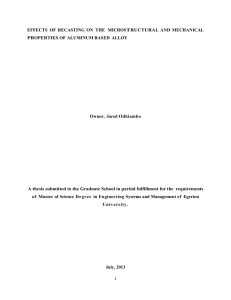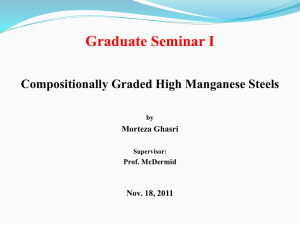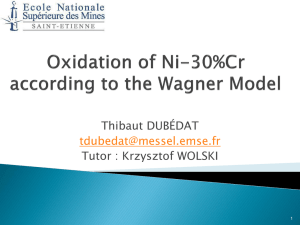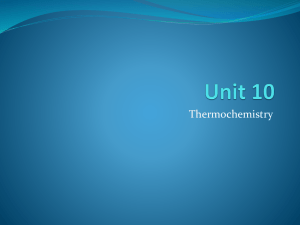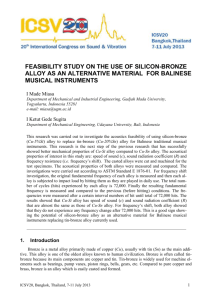Chapter 6
advertisement
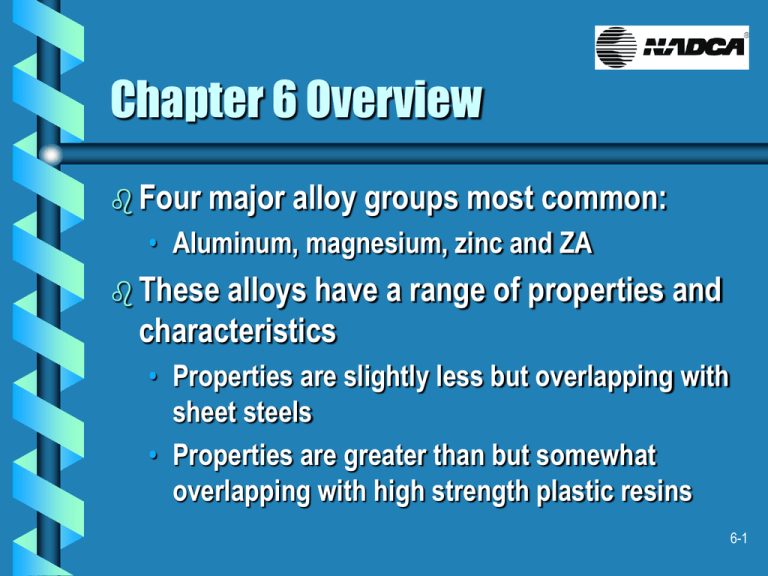
Chapter 6 Overview Four major alloy groups most common: • Aluminum, magnesium, zinc and ZA These alloys have a range of properties and characteristics • Properties are slightly less but overlapping with sheet steels • Properties are greater than but somewhat overlapping with high strength plastic resins 6-1 Chapter 6 Objectives Correctly identify the most common alloy from each major group Identify the alloy with the highest strength Identify the major alloying ingredients from an alloy specification List nine important criteria used to select an alloy for a particular job 6-2 New Terms Tensile strength • Maximum stress achieved when pulling a test specimen to failure in the direction of its length Yield strength • Level of strength at which elastic strain becomes plastic strain 6-3 New Terms Elongation • Amount of permanent extension in the vicinity of the fracture in the tension test Modulus of elasticity • Slope of the elastic portion of the stress-strain curve in mechanical testing 6-4 Mechanical Properties Properties include: tensile strength (ultimate), yield strength, elongation (ductility), and modulus of elasticity (MOE) Predicts how alloy will react to stressed condition • “Strong” alloy: high values of tensile and yield strengths and MOE, and low values of elongation • “Weak” alloy: low strengths and MOE, and higher values of elongation 6-5 Aluminum Alloy Characteristics Has a specific gravity of 2.7= lightweight As a base, it has 3 primary alloying ingredients: silicon, copper and magnesium All the other ingredients can be called impurities • In some cases impurities must be controlled at specific levels, in other cases the level of impurity may be an economic compromise 6-6 Aluminum Product Applications 380 aluminum alloy most commonly used • Lawn mower housings, electronics chassis, engine components, home appliances, tools 383 and 384: for intricate components, improved die filling, improved resistance to hot cracking 360: improved corrosion resistance, superior strength 6-7 Aluminum Product Applications 443: greatest ductility 413: excellent pressure tightness, highly fluid and useful for intricate detail 390: greatest wear resistance 518: very good corrosion resistance and ductility; used in marine and aircraft hardware and also in escalators 6-8 Magnesium Alloy Characteristics Has a specific gravity of 1.74 = lightest commonly used structural metal As a base, it has 4 primary alloying ingredients: • Aluminum, zinc, manganese and silicon All other ingredients are impurities and are controlled to maximum limits 6-9 Magnesium Product Applications AZ91D: found in drive train automotive components as well as handheld and laptop computers AM60A: has good elongation and toughness; used in automotive wheels and steering wheels and archery equipment AS41A: has creep strength at elevated temperatures 6-10 Zinc Alloy Characteristics Has a specific gravity of 7.0 = one of the heavier commonly used structural metal As a base, has 3 primary alloying ingredients: • Aluminum, magnesium and copper All other ingredients are impurities and are controlled to maximum limits Sometimes referred to as Zamak Highest purity of the die casting alloys 6-11 Zinc Alloy Product Applications #3 zinc: specified most frequently for functional and hardware castings #5 zinc: has higher tensile strength, hardness, creep resistance; automotive locks #7 zinc: has slightly lower hardness and higher ductility; higher fluidity than either #3 or #5; could be a better choice for thinner walls and finer detail 6-12 ZA Alloy Characteristics Developed in 1950’s Alloys of zinc, aluminum and copper Superior properties over • • • • Zinc Alloys Wear resistance Creep resistance Higher strength Lighter weight 6-13 9 Criteria: Alloy Cost An important factor in overall product cost Cost of alloy should be converted to a volume basis Aluminum alloys usually have lowest cost per cubic inch Magnesium and zinc can be competitive because can be cast with thinner walls and at reduced volume 6-14 9 Criteria: Process Cost An important component of overall product cost Alloys run with hot chamber process usually run in smaller DCMs and at higher production rates than equivalent casting with the cold chamber process Maintenance and replacement costs can vary significantly 6-15 9 Criteria: Structural Properties Aluminum alloys have the highest modulus of elasticity (MOE) • Relatively high strength/low density Magnesium has lower strength and rigidity • Competitive with aluminum in some applications through strategic placement of reinforcing ribs ZA alloys offer highest tensile and yield strengths 6-16 9 Criteria: Minimum Weight Magnesium alloys are the dominant choice if weight must be minimized 6-17 9 Criteria: Impact Strength and Dent Resistance Highest among the zinc (Zamak) alloys • Diminishes sharply as temperature is reduced below 32ºF (0ºC) Impact resistance of aluminum and magnesium alloys varies within each alloy group 6-18 9 Criteria: Surface Finish Surface finish best achieved by the zinc and magnesium alloys • Die steel surface quality is essential to casting surface quality 6-19 9 Criteria: Corrosion Resistance Corrosion resistance varies from alloy to alloy and within an alloy group • Can be improved with low-cost surface treatments 6-20 9 Criteria: Bearing Properties and Wear Resistance Bearing properties and wear resistance • Good for hydrodynamic bearing applications • If partial lubrication only, ZA alloys and 390 aluminum resistant to abrasion and wear 6-21 9 Criteria: Machineability Machineability of all alloys excellent • Magnesium alloys offer best machinability in terms of tool life, energy consumption and low cutting forces 6-22 Freezing Same as water Various metals freeze at a particular temperature for that metal Time versus temperature chart is slightly different than that for elements (pure metals) and compounds 6-23 Quality Alloy chemical composition is controlled by an ASTM, American Society for Testing and Materials, specification Each die casting plan has a method for maintaining alloy quality • Begins with purchasing of material, and continues through manufacturing process and shipment 6-24 Quality: Cleanliness Cleanliness component of alloy quality Not as easily checked as chemical composition Each time alloy is melted, some material is oxidized • Oxides are impurities in alloy that could affect the casting’s properties if not removed • Processes to minimize amount of oxidation and 6-25 remove the oxides from the alloy Summary Designers consider range of issues when creating a die casting Each alloy has different mechanical properties: tensile strength, yield strength, elongation, and MOE The alloy chosen must be appropriate to the die casting’s application Alloy selection is based on characteristics 6-26 and properties of the alloys in 9 categories

